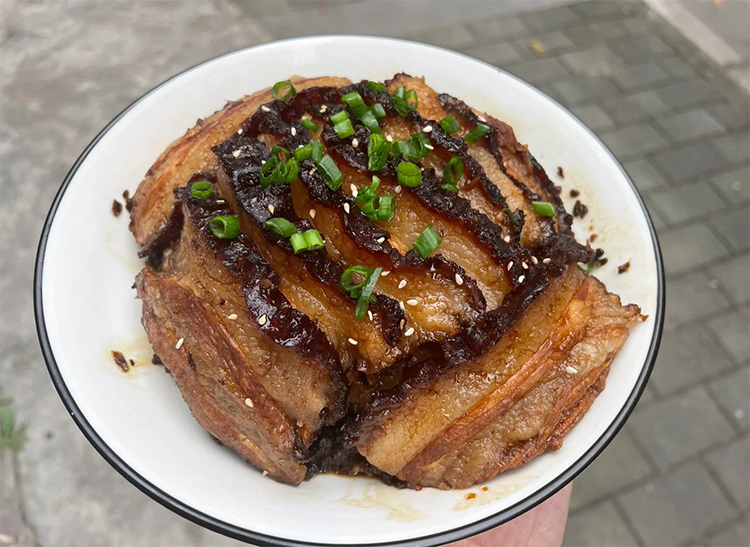Xian Shao Bai: Sichuan Salted Pork Delight
Imagine pork belly slow-steamed until the fat and lean layers become unbelievably tender, almost melting on the tongue; rich salted umami permeates every bite, blending perfectly with the refreshing, tangy aroma of pickled mustard stems. This is Xian Shao Bai, a Sichuan banquet classic that showcases the essence of Sichuan cuisine. It is both a centerpiece at family feasts and a comforting everyday dish. For food lovers visiting Sichuan, missing an authentic bowl of Xian Shao Bai means your culinary journey is incomplete.
1. A Long History: From Folk Wisdom to Banquet Staple
The story of Xian Shao Bai reflects Sichuan’s culinary evolution among ordinary people. Originating from home kitchens rather than imperial ones, locals developed the “shao bai” method to preserve and enhance pork flavor. This involves boiling the pork, frying or searing it, and then steaming it. “Shao” refers to the early-stage charring that enhances color and texture, while “bai” reflects the pale, glossy appearance of the steamed fat.
Over the years, this humble home dish gained a celebratory red sheen and unbeatable flavor, earning its place as a must-have at Sichuan banquets, often paired with the sweeter variant Tian Shao Bai, showcasing abundance and care in traditional feasts.
2. The Soul of Sichuan Flavor: Savory, Tender, and Deeply Fermented
While many visitors associate Sichuan cuisine with numbing-spicy flavors, Xian Shao Bai highlights the savory-salt profile. The dish relies less on chili or Sichuan pepper and more on ingredient quality and refined technique, producing deep, mellow umami. Fermented seasonings such as fermented soybeans and preserved vegetable juices add richness over time.
At family gatherings or wedding banquets, a steaming bowl of Xian Shao Bai symbolizes prosperity. It reflects Sichuan people’s warmth and culinary ingenuity.

3. Key Ingredients: Simple Components, Extraordinary Taste
A great Xian Shao Bai depends on a few essential ingredients:
- Pork belly: Center-cut with skin on, showing clear fat and lean layers. Steaming melts the fat while keeping the lean tender.
- Pickled mustard stems (芽菜): Especially famous are Yibin pickled mustard stems. Their salty, slightly acidic aroma balances the richness of the pork.
- Finishing touches: Small amounts of fermented black beans (douchi), Sichuan pepper, minced ginger, garlic for stir-frying the pickles, and glazing sauces (soy sauce, caramelized sugar, or honey) applied to the skin for layered flavor.
4. Craftsmanship: Flavor Forged by Time and Technique
Making Xian Shao Bai is a slow, careful process:
- Boil: Simmer pork belly in water with ginger, scallion, and Sichuan pepper until set and odor-free.
- Fry/Sear: Brush skin with glaze (soy or caramel), then fry or sear skin-side down to create a crisp, tiger-skin-like exterior.
- Slice and stack: Cut into uniform slices and arrange in a bowl, skin-side down.
- Stir-fry and layer: Sauté pickled mustard stems, fermented beans, and aromatics, then layer over the pork.
- Steam: High-heat steaming for at least two hours draws fat into the pickles, tenderizes lean meat, and melds all flavors into the signature “savory, tender, melt-in-the-mouth” experience.

5. Flavor and Texture: A Symphony on the Palate
A slice of Xian Shao Bai trembles with softness. The fat dissolves in your mouth, releasing plush pork aroma without greasiness, thanks to pickled mustard stems that neutralize oil. Lean fibers remain slightly resilient, soaked in thick savory juices. The fermented tang and textured bite of the pickles, plus savory notes from fermented beans, create harmonious layers—a gentle texture yet bold flavor.
6. How to Eat It Like a Local
Xian Shao Bai is often served as a shared bowl. Locals enjoy it with steamed rice:
- Best pairing: Place a slice of pork and some pickles over rice, press lightly, and scoop—a perfect combination of fatty richness, salty pickled tang, and rice sweetness.
- Refreshing sides: Stir-fried greens or cold salads like cucumber slices balance richness.
- Atmosphere: Eating in a bustling local eatery enhances the sensory experience with steam and chatter.

7. Traveler Tips: Where to Find the Most Authentic Versions
- Where to eat: Hidden gems, old-brand eateries, casual Jianghu-style restaurants, and local cafes in Chengdu, Yibin, and Zigong serve remarkable Xian Shao Bai. Follow local diners for the best results.
- Ordering tips: Usually listed under steamed dishes or Sichuan staples. Some places make limited daily portions due to slow steaming—arrive early or check availability.
Xian Shao Bai is a must-try for anyone exploring Sichuan cuisine. Its layered history, simple ingredients elevated by technique, and unforgettable taste make it an essential culinary stop on a China trip.


